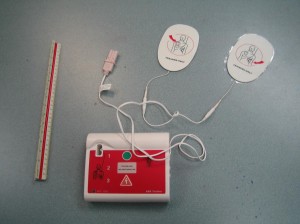Every 7 minutes, someone somewhere in Canada suffers from cardiac arrest or stroke. The chances that the victim will survive this sudden abnormal heart rhythm are very poor, unless they receive the proper treatment they need – defibrillation or electric shock to the heart – quickly. Defibrillators can help significantly reduce the number of deaths due to cardiac arrest.

Defibrillators were originally available in ambulances and hospitals. But now, they can be seen many public spaces such as airports, malls, workplaces, movie theatres casinos, fitness centres and many more. These heart-shocking devices are known as automated external defibrillators (AED) and are especially designed for public use. They are so easy to operate that even a school-aged child can use it.
The odds of surviving a cardiac arrest
According to health experts, the chances of surviving a heart attack decreases by 10% every minute that the heart stops beating or is beating insufficiently. By administering electrical shock within two minutes, the chances of survival increases by 80%. Shock the heart after seven minutes – the average time that rescue services take before they can arrive to the scene of accident – and the chances of survival are less than 30%.
If you have witnessed someone collapsed from a cardiac arrest, it is important for you to call 911. Even if there is an AED and you can deliver electrical shocks, the victim still requires professional help quickly. Alongside AED, you also need CPR to ensure that there is constant blood supply to brain and other parts of the body.
AED for home use
Just recently, the debate on whether homes should have defibrillators has come to light. According to some experts in the field of emergency medicine and public health, having a home defibrillator and knowing how to operate it could help cut the number deaths due to cardiac arrest by restoring the normal heart rhythm sooner than rescue services can. But not all experts share these same sentiments; some experts contend that it would be best to have a neighborhood first aid team who should be trained at handling AEDs. Some fear that lack of training, improper use and poor maintenance of defibrillators can only lead to further problems.
High risk group
Although there is still no conclusive statement regarding the use of AED at home, some healthcare providers recommend owning one for people who are at high risk for a cardiac event. A home defibrillator would be a worthwhile expense for someone who has previously survived a cardiac arrest but has no pacemaker. It may also be prescribed for someone who has been diagnosed with unstable angina, severe heart failure and other major heart diseases.
Training is necessary
If you decide to invest in a home defibrillator, or if you want to know how to use one, make the time to enrol in a first aid course.
Why training is a must? While AEDs are very user-friendly and mistake-free, completing a first aid course can help increase your speed and confidence using this life-saving device. Moreover, the training course will help you deal with unusual situations, such as how to use AED on a person with a pacemaker, a hairy chest, or a medication patch. The course will also teach you CPR, which is an essential part of first aid for cardiac arrest.
St Mark James Training offers first aid courses and basic life support courses (enrol here). Check with your local workplace approved chapter for training schedules.
